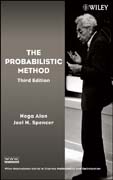
This book is the leading reference on probabilistic methods in combinatorics,and there is no direct competition. New to the Third Edition is a chapter devoted to Graph Property Testing and the included sections are Graph Property Testing; Testing Colorability; Szemeredi's Regularity Lemma; Testing Triangle-Freeness; and Characterizing the Testable Graph Properties. New sections have also been added on Percolation, Webgraphs, and Chernoff Bounds. A substantial revision has been made to the Double Jump section. The Probabilistic Method, Third Edition begins with basic techniques that use expectation and variance, as well as the more recent martingales and correlation inequalities, then explores areas where probabilistic techniques proved successful, including discrepancy and random graphs as well as cutting-edge topics in theoretical computer science. A series of proofs, or ‘probabilistic lenses,’ are interspersed throughout the book, offering added insight into the application of the probabilistic approach. The number of exercises included in the third edition has been almost doubled from that of the second edition, and hints and/or answers to some ofthe exercises are provided. INDICE: Dedication. Preface. Acknowledgments. PART I. METHODS. 1. The Basic Method. 1.1 The Probabilistic Method. 1.2 Graph Theory. 1.3 Combinatorics. 1.4 Combinatorial Number Theory. 1.5 Disjoint Pairs. 1.6 Exercises. The Probabilistic Lens: The Erd’ osKoRado Theorem. 2. Linearity of Expectation. 2.1 Basics. 2.2 Splitting Graphs. 2.3 Two Quickies. 2.4 Balancing Vectors. 2.5 Unbalancing Lights. 2.6 Without Coin Flips. 2.7 Exercises. The Probabilistic Lens: Brégmans Theorem. 3. Alterations. 3.1 Ramsey Numbers. 3.2 Independent Sets. 3.3 Combinatorial Geometry. 3.4 Packing. 3.5 Recoloring. 3.6 Continuous Time. 3.7 Exercises. The Probabilistic Lens: High Girth and High Chromatic Number. 4. TheSecond Moment. 4.1 Basics. 4.2 Number Theory. 4.3 More Basics. 4.4 Random Graphs. 4.5 Clique Number. 4.6 Distinct Sums. 4.7 The Rödl Nibble. 4.8 Exercises.The Probabilistic Lens: Hamiltonian Paths. 5. The Local Lemma. 5.1 The Lemma.5.2 Property B and Multicolored Sets of Real Numbers. 5.3 Lower Bounds for Ramsey Numbers. 5.4 A Geometric Result. 5.5 The Linear Arboricity of Graphs. 5.6Latin Transversals. 5.7 The Algorithmic Aspect. 5.8 Exercises. The Probabilistic Lens: Directed Cycles. 6. Correlation Inequalities. 6.1 The Four FunctionsTheorem of Ahlswede. and Daykin. 6.2 The FKG Inequality. 6.3 Monotone Properties. 6.4 Linear Extensions of Partially Ordered Sets. 6.5 Exercises. The Probabilistic Lens: Turáns Theorem. 7. Martingales and Tight Concentration. 7.1 Definitions. 7.2 Large Deviations. 7.3 Chromatic Number. 7.4 Two General Settings. 7.5 Four Illustrations. 7.6 Talagrands Inequality. 7.7 Applications of Talagrands Inequality. 7.8 KimVu. 7.9 Exercises. The Probabilistic Lens: Weierstrass Approximation Theorem. 8. The Poisson Paradigm. 8.1 The Janson Inequalities.8.2 The Proofs. 8.3 Bruns Sieve. 8.4 Large Deviations. 8.5 Counting Extensions. 8.6 Counting Representations. 8.7 Further Inequalities. 8.8 Exercises. The Probabilistic Lens: Local Coloring. 9. Pseudorandomness. 9.1 The Quadratic Residue Tournaments. 9.2 Eigenvalues and Expanders. 9.3 Quasi Random Graphs. 9.4 Exercises. The Probabilistic Lens: Random Walks. PART II. TOPICS. 10 Random Graphs. 10.1 Subgraphs. 10.2 Clique Number. 10.3 Chromatic Number. 10.4 ZeroOne Laws. 10.5 Exercises. The Probabilistic Lens: Counting Subgraphs. 11. The Erd’osR. enyi Phase Transition. 11.1 An Overview. 11.2 Three Processes. 11.3 The GaltonWatson Branching Process. 11.4 Analysis of the Poisson Branching Process. 11.5 The Graph Branching Model. 11.6 The Graph and Poisson Processes Compared. 11.7 The Parametrization Explained. 11.8 The Subcritical Regions. 11.9 The Supercritical Regimes. 11.10 The Critical Window. 11.11 Analogies to ClassicalPercolation Theory. 11.12 Exercises. The Probabilistic Lens: The Rich Get Richer. 12. Circuit Complexity. 12.1 Preliminaries 318. 12.2 Random Restrictions and BoundedDepth Circuits. 12.3 More on BoundedDepth Circuits. 12.4 Monotone Circuits. 12.5 Formulae. 12.6 Exercises. The Probabilistic Lens: Maximal Antichains. 13. Discrepancy. 13.1 Basics. 13.2 Six Standard Deviations Suffice. 13.3Linear and Hereditary Discrepancy. 13.4 Lower Bounds. 13.5 The BeckFiala Theorem. 13.6 Exercises. The Probabilistic Lens: Unbalancing Lights. 14. Geometry.14.1 The Greatest Angle among Points in Euclidean Spaces. 14.2 Empty Triangles Determined by Points in the Plane. 14.3 Geometrical Realizations of Sign Matrices. 14.4 QNets and VCDimensions of Range Spaces. 14.5 Dual Shatter Functions and Discrepancy. 14.6 Exercises. The Probabilistic Lens: Efficient Packing. 15. Codes, Games and Entropy. 15.1 Codes. 15.2 Liar Game. 15.3 Tenure Game. 15.4 Balancing Vector Game. 15.5 Nonadaptive Algorithms. 15.6 Half Liar Game. 15.7 Entropy. 15.8 Exercises. The Probabilistic Lens: An Extremal Graph. 16. Derandomization. 16.1 The Method of Conditional Probabilities. 16.2 dWise Independent Random Variables in Small Sample Spaces. 16.3 Exercises. The Probabilistic Lens: Crossing Numbers, Incidences, Sums and Products. 17. Graph Property Testing. 17.1 Property Testing. 17.2 Testing colorability. 17.3 Szemer edis Regularity Lemma. 17.4 Testing trianglefreeness. 17.5 Characterizing the testable graph properties. 17.6 Exercises. The Probabilistic Lens: Tur?an Numbers and Dependent Random Choice. Appendix A: Bounding of Large Deviations. A.1 ChernoffBounds. A.2 Lower Bounds. A.3 Exercises. The Probabilistic Lens: TrianglefreeGraphs Have Large Independence Numbers. Appendix B: Paul Erd’ os. B.1 Papers.B.2 Conjectures. B.3 On Erd’ os. B.4 Uncle Paul. References. Subject Index. Author Index.
- ISBN: 978-0-470-17020-5
- Editorial: John Wiley & Sons
- Encuadernacion: Cartoné
- Páginas: 384
- Fecha Publicación: 04/07/2008
- Nº Volúmenes: 1
- Idioma: Inglés
